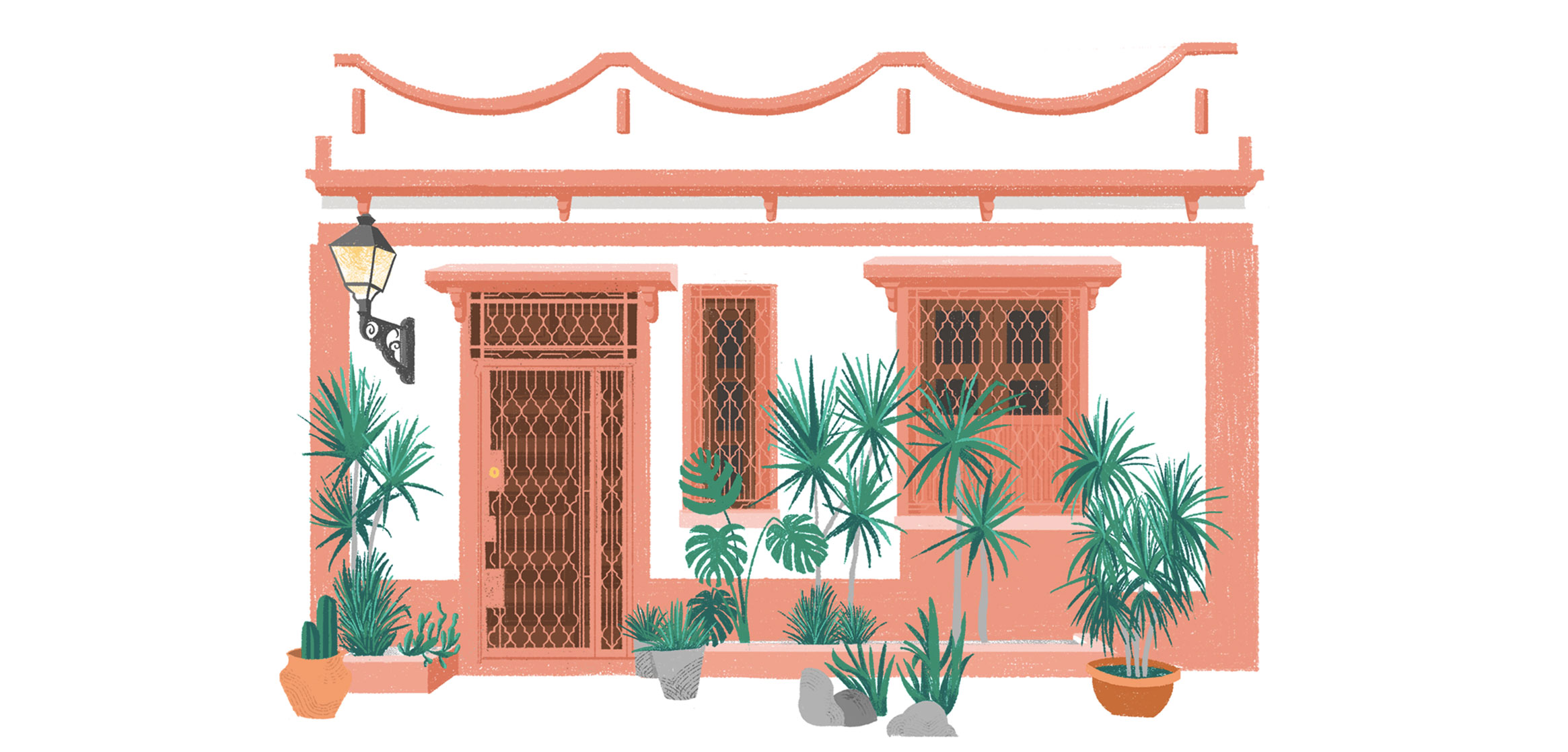

La 19 de marzo
En “Nostalgia de Santo Domingo”, exploramos la ciudad que habitamos desde distintas perspectivas: la del dominicano que ya no vive en Santo Domingo, la del que habita ahora, pero tiene curiosidad por el Santo Domingo del pasado, y la del que ha vivido varias transformaciones de la ciudad a lo largo de su vida.
In “Nostalgia de Santo Domingo”, we explore the city we inhabit from different perspectives: The one of the Dominican who no longer lives in Santo Domingo, the one who lives now, but who is curious about the Santo Domingo of the past, and the one who has lived several transformations of the city throughout its life.
Carmen Deñó es una diseñadora gráfica e ilustradora dominicana a la que siempre le tocó cambiar de casa: vivió en La Romana durante 10 años hasta que se mudó a Santo Domingo. A los 22 años se fue a Madrid a estudiar. Tras graduarse, regresó a su país natal para empezar su carrera como Diseñadora Gráfica y seguirse desarrollando como Ilustradora, la afición que la ha ido acompañando desde pequeña. Desde hace 3 años vive cambiando de ciudad, y con ello, de casa. A través de la ilustración, ha encontrado una manera de atesorar las casas de su entorno. Actualmente, abraza a Santo Domingo desde Santiago de Chile.
Carmen Deñó is a Dominican graphic designer and illustrator whom always had to change houses: she lived in La Romana for ten years until she moved to Santo Domingo. At 22 she went to Madrid to study. After she graduated, she went back to her mother land to start her career as Graphic Designer and Illustrator, the hobby that has been accompanying her since childhood. For 3 years she has been changing cities, and with that, homes. Through the illustration, he has found a way to treasure the houses of his environment. Currently, he hugs Santo Domingo from Santiago de Chile.
Capital: ¿Dónde quedaba tu casa en la Zona Colonial? Carmen Deñó: Mi casa en la Zona Colonial quedaba en la 19 de marzo, entre Portes y Billini, justo al lado de la casa de Sánchez, que ahora es patrimonio histórico.
Capital: Where was your house at Zona Colonial? Carmen Deñó: My house in the Colonial Zone was in 19 de Marzo, between Portes and Billini, right next to Sanchez’ house that it is now historical heritage.
C¿Cómo era un día en la vida de Carmen en la Zona Colonial? C¡Ay! ¡mis días en la Zona Colonial! Te voy a describir un día cualquiera en la semana. Me levantaba, desayunaba con mi esposo en el balcón. El residencial donde vivíamos tenía una fachada colonial, pero por dentro lo habían remodelado, y estaba súper bonito. Tenía un jardín con muchísimas plantas.
CHow was a day in Carmen’s live in Zona Colonial? C Wow! My days in the Colonial City! I'll describe you any weekday. I got up, had breakfast with my husband on the balcony. The residential where we lived had a colonial facade, but was remodeled in the inside, and it was super nice. I had a garden with many plants.
Luego, cuando él se iba para el trabajo, como yo trabajo desde casa, empezaba a trabajar también. A mediodía, salía a caminar para ir al súper, El Nacional de la Calle El Conde, porque ahí tienen los platos del día, o si no, cruzaba al frente de mi casa, a un restaurante vegetariano. Había otro lugar en la Calle Sánchez, que tenían platos del día. Yo tenía muchos sitios de la Zona donde podía comer. Comía en cualquiera de esos lugares, si era del súper, me lo llevaba a casa y me lo comía en el balcón, luego seguía trabajando.
Then, when he left for work, because I worked from home, I started working. At noon I went out for a walk to the supermarket, El Nacional in El Conde street, because they hay the dish of the day, or in front of my house to a vegetarian restaurant. There was another place in Sánchez street, that had the dish of the day. I had many place that I could eat. I ate in any of those, if it was from the supermarket I’d take it home and ate at the balcony, then kept working.
En la tarde, cuando llegaba Raf, usualmente subíamos a la azotea, que tenía una súper vista de la Zona. Subíamos ahí con los amigos que vivían cerca a tomar la cervecita de la tarde.
In the afternoon, when Raf arrived, we usually went to our roof top, that had a great view. We went upstairs with friends that lived nearby to drink the “afternoon beer”.
Los fines de semana era buenísimo vivir en la zona, porque la mayoría de las fiestas, por lo menos las que yo frecuentaba, se hacían ahí, entonces no tenía que manejar, me iba caminando. Era muy cómodo vivir en la Zona, lo extraño mucho.
On the weekends it was awesome living in the zone, because most parties, at the the ones I went to, were there, so I didn’t have to drive and went walking. It was very confortable living there, I miss it a lot.
C¿De dónde surge ese interés de dibujar casas coloniales? CEl interés de dibujar casas, en general, viene del hecho de que yo me he pasado los últimos 3 o 4 años como una nómada, yo no tengo una casa fija, o una casa que yo pueda vivirla por más de uno o dos años, así son los períodos. Entonces cuando estaba en la Zona Colonial, que regresé para Santo Domingo después de Washington, quería absorber todo lo que pudiera de mi barrio, mi casa, y la forma en la que eso se me dio fue dibujándola. Si te pones a tirar fotos en el celular, no necesariamente las vas a ver. Sin embargo, si lo dibujas, te conectas mucho más con lo que estás dibujando, incluso puedes memorizarlas. Es una forma de quedarme con algo de donde viví, y recordarlo más fielmente.
CWhere does that interest from drawing colonial houses comes from? C The interest of drawing houses in general, comes from the fact that I have spent the last 3 or 4 years as a nomad, I do not have a fixed house, or a house that I can live for more than one or two years, that's how the periods are. So when I was in the Colonial Zone, I came back to Santo Domingo after Washington, I wanted to absorb everything I could from my neighborhood, my house, and the way it was given to me was drawing it. If you start making pictures with your cell phone, you will not necessarily see them. However, if you draw it, you connect much more with what you are drawing, you can even memorize them. It is a way of keeping something from where I lived, and remembering it more faithfully.
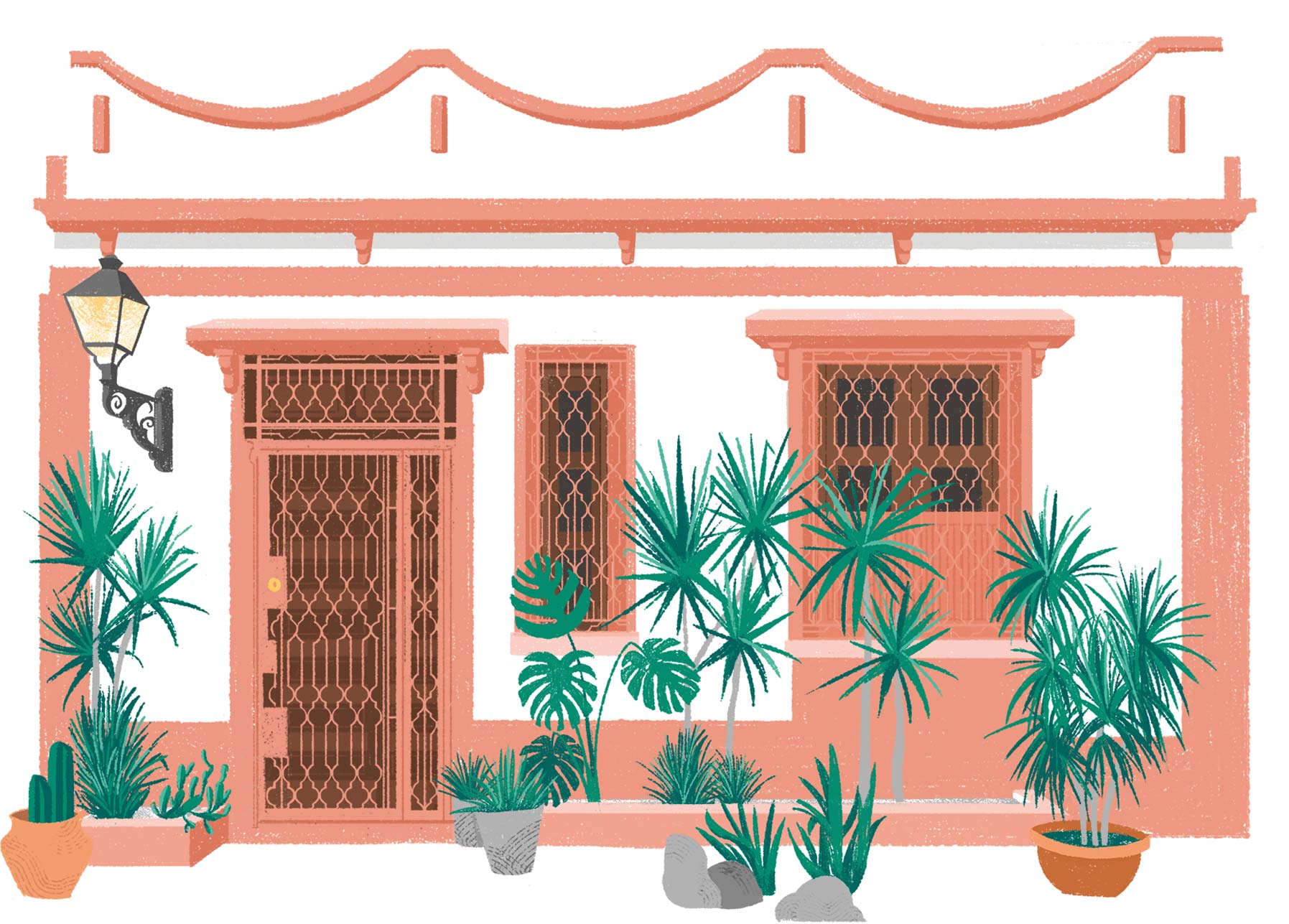
Regina
Realmente no empecé a dibujar casas con las fachadas de la Zona Colonial, que la mayoría eran sitios que me quedaban cerca. Empecé con unas casitas de Menorca cuando fui por primera vez hace como dos años, porque me llamó muchísimo la atención la uniformidad de Menorca, casi todas, por no decir todas las casas, son blancas, tienen detalles azules, y los techos de tejas. Mis suegros tienen una casa ahí, y mi esposo pasó mucho tiempo de su infancia yendo todos los veranos para Menorca. Estando allá, me di cuenta de que mi suegra todavía usa postales para enviárselas a sus amigas, me pareció un detalle súper lindo. Y para esa navidad, le regalé una serie de postales de casas de Menorca, incluyendo la casa de ellos, para que le pudiera regalar a sus amigos. Ahí fue cuando empecé a dibujar casas.
I did not really start drawing houses with the facades of the Colonial Zone, which were mostly places that were close to me. I started with some small houses in Menorca when I went for the first time about two years ago, because the uniformity of Menorca caught my attention: almost all, not to mention all the houses, are white, have blue details and the roofs of tiles. My in-laws have a house there, and my husband spent a lot of his childhood going to Menorca every summer. While there, I realized that my mother-in-law still uses postcards to send to her friends, it seemed a super cute detail. And for that Christmas, I gave her a series of postcards of houses in Menorca, including their own, so she could give them to his friends. That's when I started drawing houses.
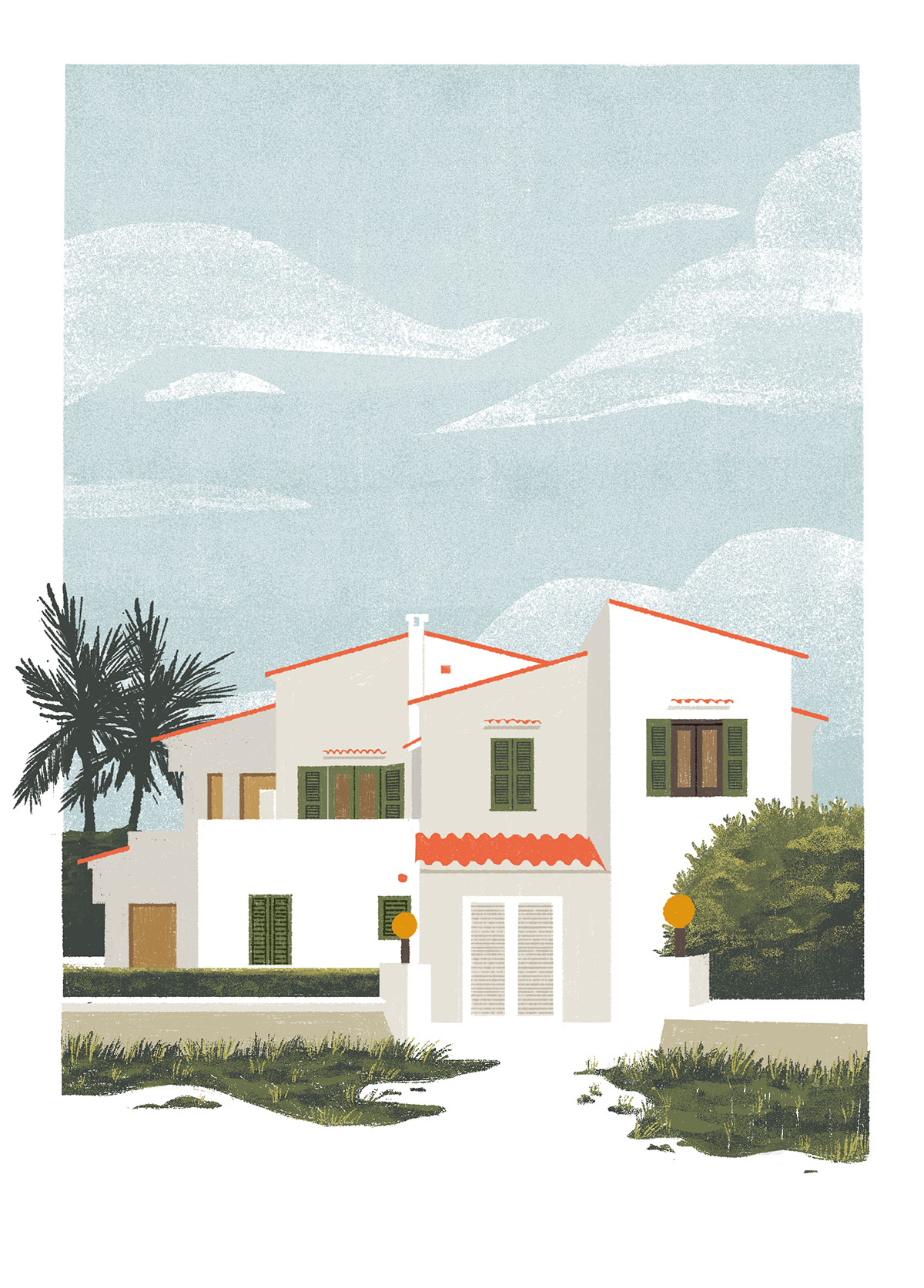
Menorca Los Van der Borght
Aparte, no sé, es algo muy mío el querer guardar cosas, coleccionarlas. Tener alguna forma de conservar las cosas. Lo que he estado viendo es que están demoliendo todas las casas interesantes de nuestro país para hacer torres enormes, todas iguales. Y las casitas más pequeñas pero con más personalidad, ya son cosa del pasado. Es una forma para mí de guardarlas un poco, aunque sea en mi memoria. Es una pena de verdad, siento que no se le da mucho seguimiento a nuestro patrimonio, como en otras ciudades.
Besides, I don’t know, it's something very much my own to want to keep things, to collect them. Have some way to keep things. What I've been seeing is that they're demolishing all the interesting houses in our country to make huge towers, all the same. And the smaller houses, but with lot of personality, are already a thing of the past. It's a way for me to keep them a little, even if it's in my memory. It's a real shame, I feel that our heritage is not closely monitored, as in other cities.
CEse fenómeno de las torres se ve mucho en la zona céntrica de Santo Domingopero en la Zona Colonial aún conservan las casas, por suerte CYo creo que ahí no pueden hacer mucho, porque mantener la Zona Colonial como está, es el atractivo turístico, entonces no es conveniente que las cambien.
CThat phenomenon of the towers is seen a lot in the downtown area of Santo Domingobut in the Colonial Zone they still conserve the houses, luckily! CI believe that there can not be much done, because to maintain the Colonial Zone as it is, is a tourist attraction, so it is not convenient to change them.
CY cuando ibas a dibujar las casas, ¿cómo era tu proceso? CMi proceso para todas, para las de Menorca y las de Santo Domingo, era primero salir a hacer una recopilación de referencias visuales, darme mi vueltica por el barrio, ver qué me parecía interesante, qué me llamaba la atención. Me llamaban la atención diferentes cosas, desde las casas más “bizcochito” hasta casas de madera. Después de que hacía una recopilación, hacía una selección de las que me parecían más interesantes visualmente, y empezaba a dibujarlas.
CAnd when you went to draw houses, what was your process? CMy process for all, for those of Menorca and those of Santo Domingo, was first to go out and do a compilation of visual references, walk around the neighborhood, see what I found interesting, what called my attention. Different things attracted my attention, from the most colorful houses to wooden houses. And after I made a compilation, I made a selection of the ones that seemed most interesting to me visually, and then I began to draw them.
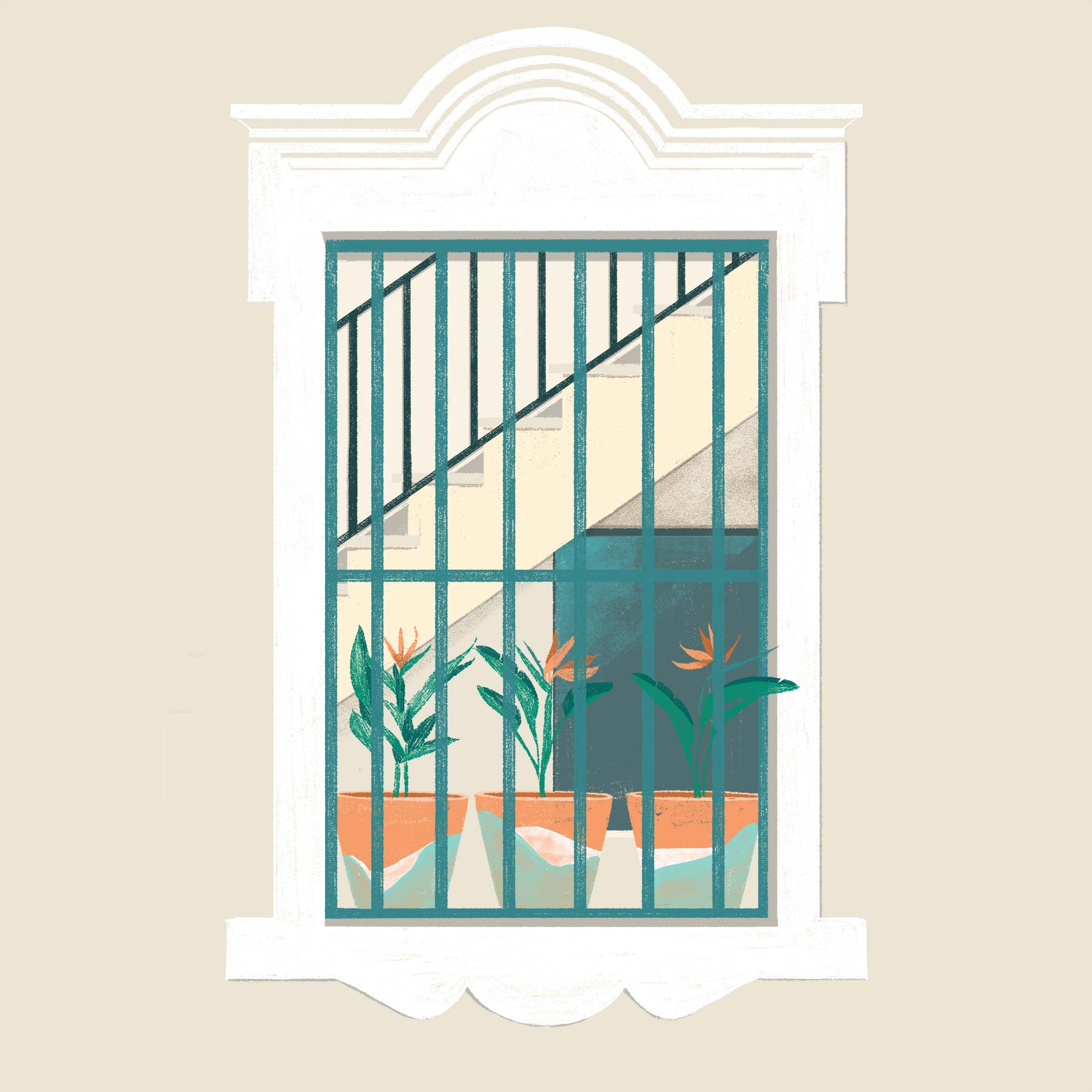
Ventana frente a mi casa en la 19 de marzo
C¿Ahora en qué zona de Santiago de Chile vives? CVivo en una zona que se llama Providencia, en Santiago.
CIn which part of Santiago de Chile you live now? CIt’s called Providencia, in Santiago.
CY viviendo en providencia, ¿qué extrañas de tu casa de la Zona Colonial? C¡Ohh! ¡todo! de las casas en las que he vivido, esa casa de la Zona Colonial estaba bien. Extraño cosas generalísimas como el clima, ver el sol todos los días, porque en Santiago se puede esconder bastante. Poder subir a bañarme en la piscina, en la azotea. Tener a mis amigos cerca, invitarlos a casa, a la piscina. Este barrio, por lo menos en mi calle, y las calles adjuntas, es de gente mayor, lo ves por la gente que camina en la calle. Y la Zona Colonial es muy joven, los domingos salía al Parque Duarte y me encontraba con muchísimos amigos. La Zona es un barrio muy vivo, siempre hay una fiesta, música, un lugar donde comer, una exposición que ver. “Provi" es más tranquilo.
CAnd living in Providence, what do you miss the most about Zona Colonial? COhh! Everything! Of the houses in which I have lived, that house in the Colonial Zone was fine. I miss general things like the weather, see the sun every day, because in Santiago it hides a lot. Being able to go up to bathe in the pool, on the roof. Have my friends nearby, invite them home, to the pool. This neighborhood, at least on my street, and the adjoining streets, is of older people, you see it because of the people who walk on the street. And the Colonial Zone is very young, on Sundays I went to Duarte Park and I met many friends. The Zone is a very lively neighborhood, there is always a party, music, a place to eat, an exhibition to see. "Provi" is quieter.
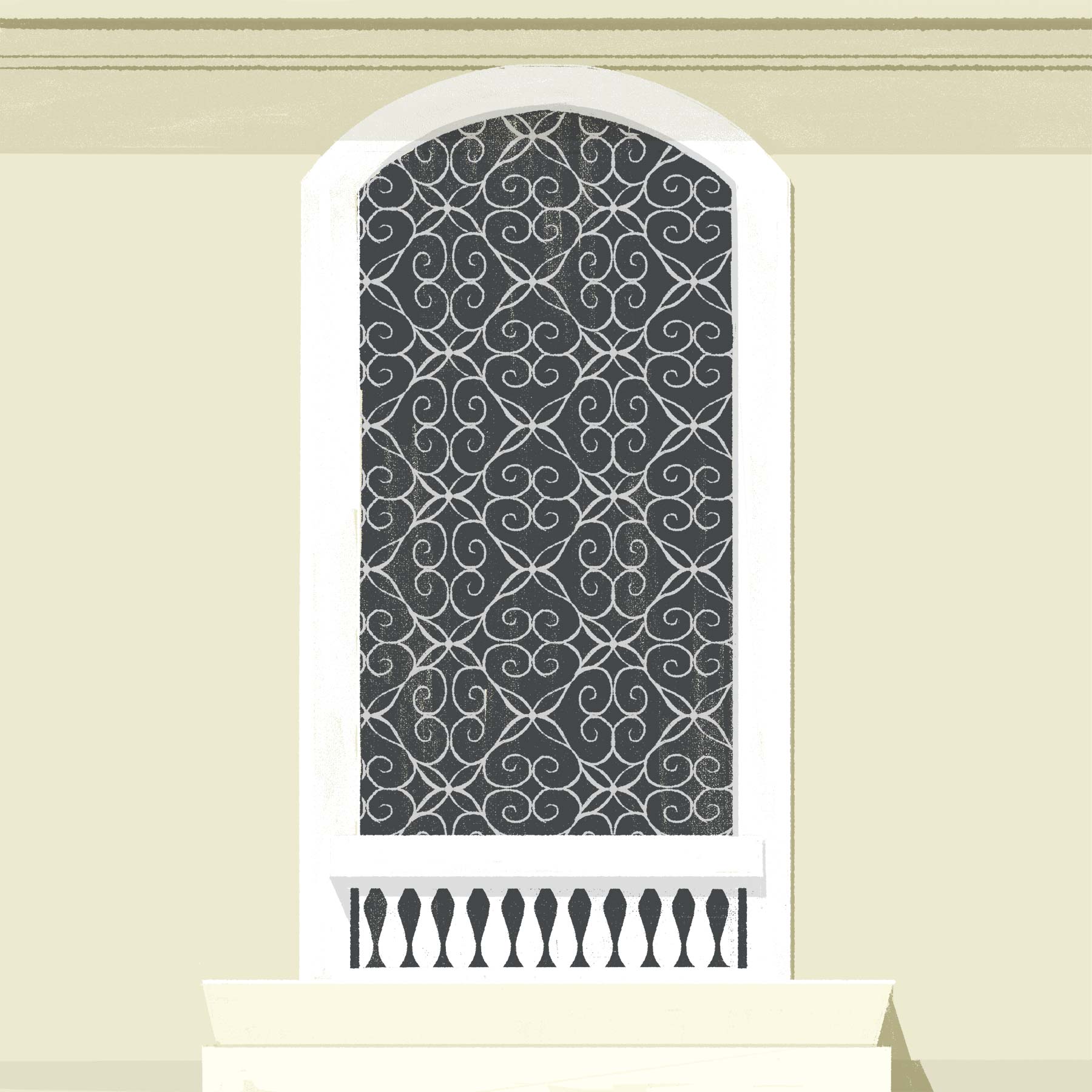
Ventana al Parque Duarte
CTe he visto dibujando sillas plásticas y confetis, dos cosas que te encuentras en el típico cumpleaños dominicanos, ¿lo haces a modo de terapia?
CI have seen you drawing plastic chairs and confetti, two things that you find in the typical Dominican birthday, do you do it as a therapy?
C¡Wao!, esa pregunta me dio en lo profundo del corazón. Te voy a hacer una confesión: En el tiempo en el que mi trabajo de ilustración se puso más lento, era porque lo asociaba más con trabajo comisionado. Y me olvidé por mucho tiempo de que yo he dibujado la vida entera, y en los tiempos de mi vida en los que más he dibujado, era cuando no era por trabajo, era a modo de terapia, a modo de encerrarme en un mundito y aislarme de otro. La verdad es que casi todo lo que yo dibujo es un poco terapéutico, sobre todo el trabajo personal. Y bueno, sí, me sirve como terapia porque estoy muy en añoranza de Santo Domingo, porque todavía me estoy adaptando a Chile. Además Rafa y yo somos unos nómadas, vamos a durar 2 años en Santiago, y de ahí nos mudamos. En lo que me adapto, me sirve dibujar esas cosas de Santo Domingo, como una forma de abrazarlo desde lejos.
CWow, that question hit me deep in the heart. I'm going to make a confession: At the time my illustration work slowed down, it was because I associated it more with commissioned work. And I forgot for a long time that I’ve been drawing my whole life, and in times of my life where I have drawn the most, it was when it was not for work, it was as a therapy, as a way of locking myself in a world and isolate myself from another. The truth is that almost everything I draw is a little therapeutic, especially personal work. And well, yes, it serves as therapy because I am very homesick for Santo Domingo, because I am still adapting to Chile. Besides Rafa and I are nomads, we will last 2 years in Santiago, and from there we moved. In the meantime while I adapt, it helps me to draw those things of Santo Domingo, as a way to embrace it from afar.

Breezeblock Partay
CY tú viéndolo desde allá, ¿crees que los que vivimos en Santo Domingo apreciamos nuestra ciudad? C¡No! Para nada, ¡jajaja!. Santo Domingo es como una pintura impresionista, tienes que alejarte para ver lo lindo de ella, porque cuando estás ahí estás sofocado por los tapones, el desorden, el millón de cosas que te abruman. Alejarme varias veces de mi ciudad me ha permitido poner las cosas más en perspectiva, sobre todo alejarme en el contexto latinoamericano. Yo era la primer que me quejaba de mi ciudad, pero tuve que alejarme para apreciar muchas cosas, como el clima, la calidez de la gente… Uno lo que tiene es darle su abrazo a Santo Domingo, y alejarse un chin para poner las cosas en perspectiva.
CYou living there, do you think that the ones that live in Santo Domingo appreciate this city? C No! Not at all, hahaha! Santo Domingo is like an impressionist painting, you have to walk away to see how beautiful it is, because when you are there you are suffocated by the traffic, the disorder, the million things that overwhelm you. Going away several times from my city has allowed me to put things more in perspective, especially moving away in the Latin American context. I was the first to complain about my city, but I had to get away to appreciate many things, like the weather, the warmth of the people... One should give a hug to Santo Domingo, and get away to put things in perspective
He observado que en países asiáticos y latinoamericanos, y sobre todo en República Dominicana, Tenemos el autoestima baja sobre quienes somos, cuando te pones a comparar y te pones a andar, puedes decir “Wao, ¡nosotros sí estamos bien!” ¡Lo digo de corazón! Hay espacio para mucha mejoría, pero es cuestión de poner las cosas en perspectiva.
I have observed that in Asian and Latin American countries, and especially in the Dominican Republic, we have low self-esteem about who we are, when you start to compare and start walking, you can say "Wao, we are fine!" of heart! There is room for much improvement, but it is a matter of putting things in perspective.
CMe habías comentado que ibas a seguir con tu proyecto de dibujar casas, ¿seguirás con casas coloniales o buscarás casas en Santiago? C ¡Chan chan chan! ¡jajajaja! Lo de las casas lo veo como un proyecto a largo plazo, porque eventualmente me gustaría poder abarcar principalmente las ciudades en las que he vivido, luego las ciudades que he visitado cuyas casas me han llamado la atención. Lo tuve que poner en pausa porque este año a nivel de trabajo fue muy demandante, pero quisiera retomarlas, sobre todo porque ahora tengo un banco de viaje y de imágenes de casas como referencia, que es bien amplio. Tengo un montón de ideas sobre cómo continuaré con este proyecto, es algo que lo tengo muy cercano a mi corazón de nómada, de alguien que “no tiene casa”. A ver, sí tengo casa, pero no me puedo encariñar mucho con una casa en la que viva, porque no viviré ahí más de año y medio o dos, como mucho. En una ocasión, en Washington, viví 10 meses, ni siquiera llegué al año.
CYou told me that you were going to continue with your project of drawing houses, will you continue with colonial houses or will you look for houses in Santiago? C Chan chan chan! Hahaha! I see the houses as a long-term project, because eventually I would like to be able to cover mainly the cities in which I have lived, then the cities I have visited whose houses have caught my attention. I had to put it on pause because this year at work level was very demanding, but I would like to take them up, especially since I now have a travel bank and house images as a reference, which is very broad. I have a lot of ideas on how I will continue with this project, it is something that I have very close to my nomadic heart, of someone who "has no home". Let's see, I do have a house, but I can not be very fond of a house where I live, because I will not live there more than a year and a half or two, at the most. On one occasion, in Washington, I lived for 10 months, I did not even get a year.
Conoce el trabajo de Carmen Deñó en www.carmendeno.com
Follow the work of Carmen Deñó at www.carmendeno.com